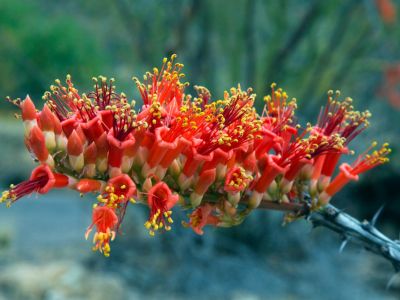Ocotillo, scientifically known as Fouquieria splendens, is a striking, multi-stemmed succulent native to the arid regions of the southwestern United States and northern Mexico. Its unique appearance, featuring long, slender canes that can reach up to 20 feet in height, makes it an engaging addition to any landscape, particularly in xeriscaped gardens. In this guide, we will walk you through the intricate process of planting and nurturing an Ocotillo, ensuring that this remarkable plant thrives in your garden.
Before delving into the planting process, it’s important to familiarize yourself with the basic requirements and characteristics of the Ocotillo. Understanding its natural habitat will significantly enhance your chances of cultivating a robust specimen.
Understanding the Ocotillo’s Natural Habitat
Ocotillo thrives in extremely arid conditions, preferring well-draining sandy or rocky soils. Native to desert environments, this plant flourishes under direct sunlight and is intolerant to waterlogged conditions. In its natural habitat, Ocotillo exhibits a unique growth pattern, becoming deciduous during periods of drought and fully leafing out after rainfall.
Upon successfully planting and nurturing Ocotillo, one can expect an awe-inspiring spectacle of vibrant red tubular flowers in the spring, attracting pollinators such as hummingbirds and bees. This gorgeous floral display stands in stark contrast to its bare, twig-like structure, exemplifying the adaptability of this resilient plant.
Preparation for Planting Ocotillo
Choosing the Right Location
Begin by selecting a location that receives full sun for at least 6 to 8 hours daily. The spot should be protected from strong winds, as the slender canes can be susceptible to damage. Ideally, choose an area with good air circulation to minimize the risk of fungal diseases.
Soil Assessment
The Ocotillo demands well-draining soil, so it’s crucial to assess the existing soil conditions. Conduct a soil test to determine pH levels and nutrient content; Ocotillo prefers slightly acidic to neutral soil (6.0 to 7.0 pH). If necessary, amend the soil with coarse sand or perlite to enhance drainage.
Gathering Necessary Tools and Materials
Ensure that you have the following tools and materials on hand before planting:
- Shovel or spade
- Rake
- Watering can or hose
- Mulch (such as gravel or coarse sand)
- Garden gloves
Planting Steps for Your Ocotillo
Choosing the Right Time to Plant
The optimal time to plant Ocotillo is in the spring or early summer, aligning with its active growing season. Avoid planting during extreme heat or frost, as these conditions can hinder establishment.
Preparing the Planting Hole
Dig a hole that is approximately 2 to 3 times wider than the root ball of your Ocotillo. The depth should be equal to the height of the root ball. This generous space provides room for root expansion and proper drainage. Loosen the soil at the bottom of the hole to facilitate root penetration.
Positioning the Ocotillo
Carefully remove the Ocotillo from its container, taking care not to damage the delicate roots. Position the plant in the center of the hole, ensuring that the top of the root ball is level with the surrounding soil. It’s crucial that the plant is not buried too deeply, as this can lead to root rot.
Backfilling the Hole
Once the Ocotillo is correctly positioned, backfill the hole with the excavated soil, gently pressing it down to eliminate air pockets. Avoid compacting the soil too tightly, as this can impede root growth.
Watering and Mulching
After planting, water the Ocotillo thoroughly to help settle the soil around the roots. Allow the excess water to drain away. Following this, apply a layer of gravel or coarse sand mulch around the base of the plant to enhance drainage and retain moisture without causing water accumulation around the stems.
Caring for Your Ocotillo
Watering Schedule
Ocotillo is a drought-tolerant plant, so it’s essential to establish a balanced watering routine. During the first year, water your newly planted Ocotillo once every two to three weeks, ensuring that the soil dries out completely between waterings. After the establishment period, you can reduce watering frequency to once a month or as needed.
Fertilization Insights
Ocotillo generally requires minimal fertilization, as it adapts well to nutrient-poor soils. However, during its active growing season, a balanced, slow-release fertilizer can be applied sparingly to promote healthy growth and flowering.
Pruning for Optimal Growth
While Ocotillo typically requires little maintenance, light pruning can help shape the plant and remove any dead or damaged canes. Prune during the dormant season to encourage new growth in the spring.
By following these detailed steps and acclimating to the unique characteristics of the Ocotillo, gardeners can successfully cultivate this magnificent plant, adding an exotic flair to their desert landscapes. With patience and keen observation, the Ocotillo will reward its caretaker with visually stunning blooms and resilience that epitomizes the beauty of desert flora.





Leave a Comment